Sherkin Island in Baltimore Harbour has ruins dating from the 1400s, including a castle and a friary. The island also has some excellent walking trails with views to Baltimore Harbour and the Atlantic Ocean, and two pubs, also with water views.
Trip highlights from June 12th through 14th at Sherkin Island, Ireland. Click any image for a larger view, or click the position to view the location on a map. And a live map of our current route and most recent log entries always is available at http://mvdirona.com/maps
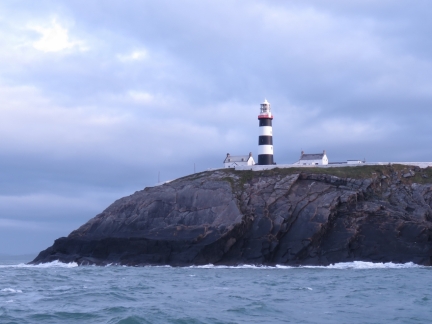 |
Old Head
Position: -8 31.58, 51 36.19
We finally dragged ourselves out of Kinsale to start our cruise of the Irish west coast. In reasonably settled conditions, we ran near the Old Head of Kinsale for a close-up view to the light.
|
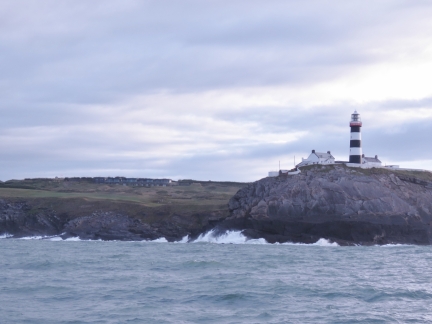 |
Clubhouse
Position: -8 32.34, 51 35.95
The Old Head Golf Links clubhouse, built into the cliffs on the head, has sweeping views to sea. The clubhouse is pretty much invisible from the north—we couldn’t see any evidence of it from the Signal Tower.
|
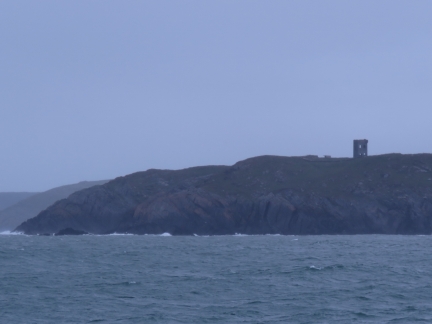 |
Seven Heads
Position: -8 41.41, 51 33.97
The Seven Head signal tower, one of the 81 signal towers built along the Irish coast during the Napoleonic era.
|
 |
Running on the Wing
Position: -8 48.53, 51 32.57
The main engine has started to signal the 1347.7 code indicating difference between actual and called for fuel pressure in the high pressure common rail, so we have started the wing engine to drive the boat and will be bringing the main engine down. If you look carefully you’ll see that the engine room temperature is way hotter than it should be and the fuel temperature is unusually high at 133F. Four problems all at once.
The engine room temperature high is a failed relay. 110F is fine, so we’ll just do the easy change of the relay when we arrive. The engine fuel and hydraulic oil temperatures both being high are almost certainly a failed impeller in the hydraulic cooling system since flow from that pump cools both fuel and the hydraulics systems. The max hydraulic system temperature is 160F for the first alarm and the max fuel temperature is 212F so neither is urgent and we’ll change the Jabsco cooling pump impeller when we get in. The only interesting issue is the 1347.7 code and alarm the main engine is producing. It’s more urgent, so we’ll shut down the engine and do the first level of diagnostics, change all the fuel filters. We should have that done in 45 min or so and we’ll see if we can get the main engine back on line. |
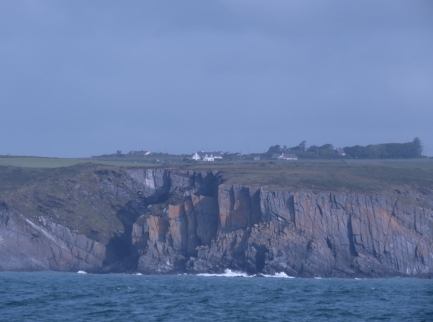 |
Sandscove
Position: -8 53.02, 51 31.70
Dramatic cliffs at Sandscove just east of Galley Head.
|
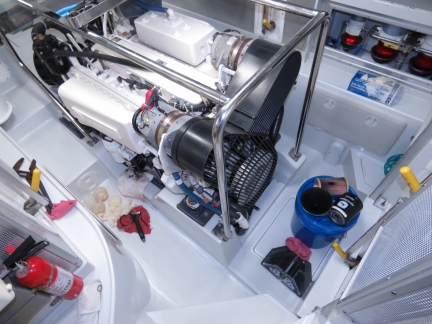 |
Changing Fuel Filters
Position: -8 53.18, 51 31.68
The main engine has just started producing a 1347.7 code and alarm signaling that the actual high pressure common rail pressure is more than 750PSI different from the called for pressure. The first level of investigation is to bring down the main engine and change all three fuel filters. We are continuing on the wing engine as we make this change.
|
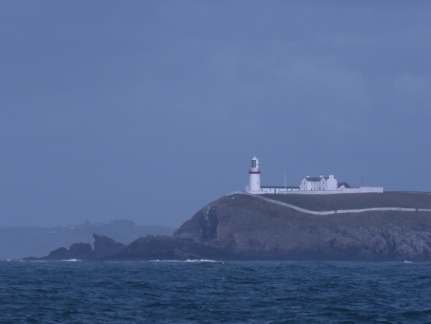 |
Galley Head
Position: -8 54.72, 51 31.37
When first constructed in 1875, the Galley Head lighthouse could be seen from 16nm away and was the most powerful in the world. The light was barely visible in the overcast morning as we approached Kinsale on our crossing.
|
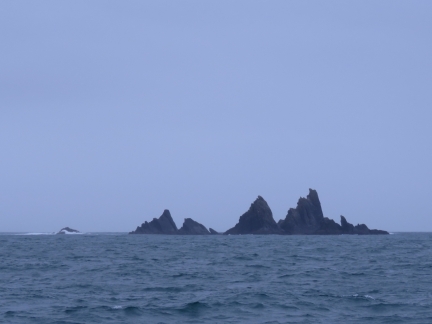 |
The Stags
Position: -9 12.18, 51 28.64
The Stags look menacing from a distance and even more so close-up.
|
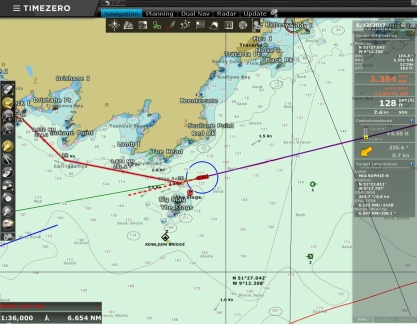 |
Kowloon Bridge
Position: -9 12.72, 51 28.56
Just south of The Stags is a buoy and an AIS target marking the shipwreck of the 965-ft (294 m) bulker Kowloon Bridge. In November of 1986, the bulk cargo carrier sustained deck damage during a rough Atlantic crossing from Quebec, Canada and sheltered in Bantry Bay north of The Stags.
Before repairs could be undertaken, a storm came up, blowing Force 10 to 12 (48 to over 64 knots) winds directly into the harbor. The anchor chain parted and the captain spent several hours attempting to keep the ship on position. But without a pilot and in an unfamiliar harbour on a lee shore, the captain eventually gave up and sought open water. As the storm continued, the ship lost steerage that night and the captain issued a Mayday. Two RAF helicopters from Cornwall rescued all 27 on board. The Kowloon Bridge eventually went aground on The Stags. Bunker oil from the ship leaked out and caused extensive damage to the nearby fishing grounds and the eco-tourism industry. |
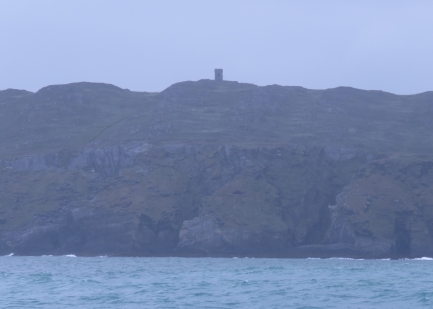 |
Kedge Point
Position: -9 20.55, 51 27.44
The Kedge Point signal tower above Baltimore, one of the 81 signal towers built along the Irish coast during the Napoleonic era.
|
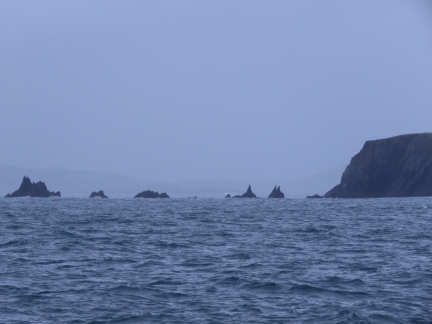 |
Carrigatrough
Position: -9 21.61, 51 27.57
A boat can apparently pass north of Kedge Island between these rocks and Spain Point on the mainland through a 50m channel called Carrigatrough. You’d want pretty settled conditions to try it though.
|
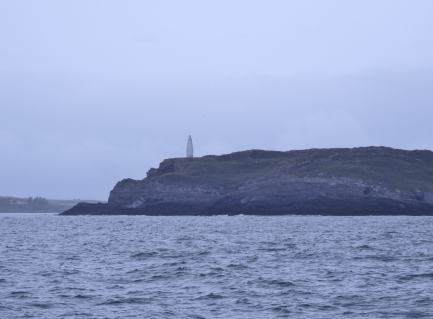 |
Baltimore Harbour
Position: -9 22.75, 51 27.99
Baltimore Harbour is a Point of Entry into Ireland and a common first landing for boats arriving from the Azores, the Caribbean and the US. The conspicuous beacon Lot’s Wife at the harbour entrance must be as welcome a sight as the Old Head of Kinsale was on our crossing.
|
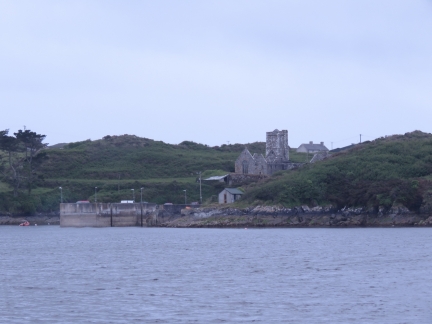 |
Sherkin Island
Position: -9 23.74, 51 28.82
The ruins of a fifteenth-century abbey above the public wharf at Sherkin Island, viewed from our anchorage off the island’s east shore.
|
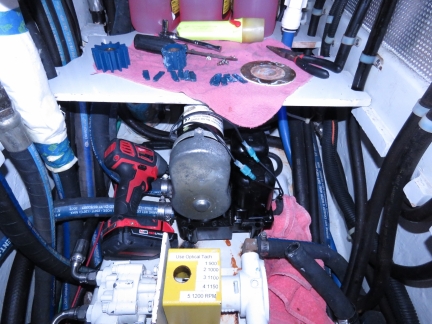 |
Impeller
Position: -9 23.75, 51 28.82
The hydraulic cooling system impeller failed shortly after getting underway today but the seawater is sufficiently cool the system never got up over 119F where the first alarm isn’t until 160F. The main engine fuel system is cooled by the same pump and the fuel temperature climbed up to 140F as we anchored but, again, not even close to the Deere limit of 212F.
The hydraulic cooling system impeller is actually very easy to change with most of the time being moving the entire new engine, hydraulic, and steering oil storage out of the way to be able to lift the floor to get access to the hydraulic cooling pump visible at the bottom of the photo. All that is easy but what can be truly nasty is chasing lost impeller fins. If fins break off, then you need to carefully inventory them and keep searching in the system until they are found. In this case the pump ran for quite a while before elevated temperatures indicated the failure so we lost some fins. In fact, we lost all but one which is unusual for Globe impellers. More than once on the generator which uses the same type of pump, we’ve needed to drain the coolant from the generator to recover fins from the heat exchanger. In this case we think what happened is the pump lost 3 or 4 fins and they lodged in the outlet pipe and plugged up the system which stopped the cooling water flow, and then most of the rest of the fins failed in short order. We found 1 fin on the impeller, 6 in the pump body, 4 at the first 90 degree fitting in the system, and 1 using a wet/dry vacuum on the outlet hose. The important thing is all 12 are accounted for. Once that’s done, it’s a snap to get the system back together and tested. |
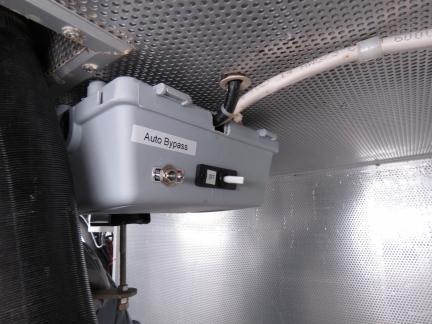 |
Override Switch
Position: -9 23.75, 51 28.82
The control relay that manages the engine room fans failed. It’s an easy change but seeing it fault reminded us that all control systems should have emergency overide switches. When this switch is actuated the fans runs independent of relay or control system state.
|
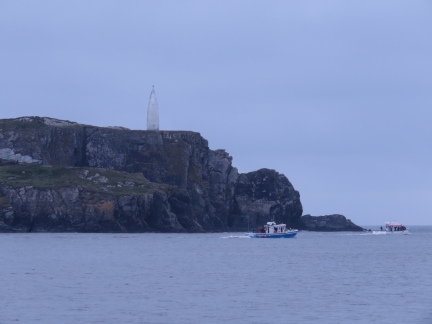 |
Fishing Vessels
Position: -9 23.76, 51 28.82
Two commercial fishing boats passing under Lot’s Wife at the entrance to Baltimore Harbour. The harbour scenery is fantastic.
|
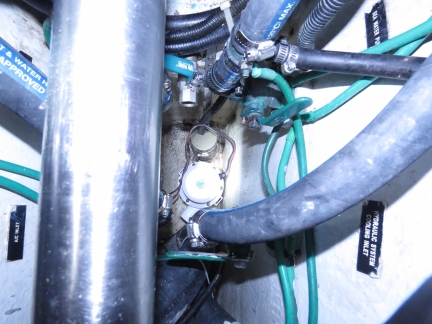 |
Bilge Pump
Position: -9 23.76, 51 28.82
This morning we investigated how we might mount a high-volume bilge pump in the main bilge. We used our spare Rule 3700, and getting it past the prop shaft and thru-hulls was very tight. Two hose clamps had to be moved, but it does fit. We’ll go with a second Rule 3700 as our new high-water bilge pump, mounted just above the bottom of the main bilge where the spare temporarily sits.
|
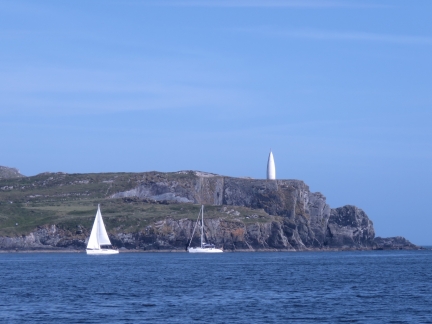 |
Sailboats
Position: -9 23.77, 51 28.83
Baltimore Harbour is a busy sailing port—local and international vessels have been coming and going the entire time we’ve been here.
|
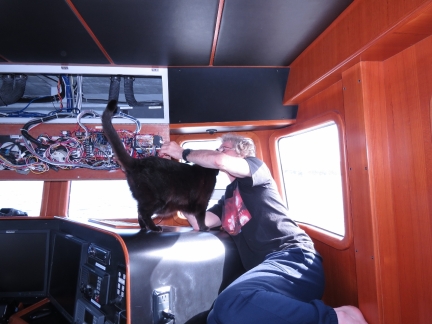 |
Spitfire
Position: -9 23.76, 51 28.83
James installing a load shed relay to temporarily shut down our diesel furnace and circulation pump when our 120V inverter is reaching maximum output. This and other shed relays allows us to largely ignore the capacity limit on our inverter. The load shed system just automatically temporarily shuts down non-essential loads during short power draw peaks and then turns them back on when the peak passes. The relays are control by a Raspberry Pi. This Pi has around 20 digital inputs to detect bilge pump cycles, wast pump cycles, furnace on, virtual watch commander on, virtual watch commander reset, etc. It also supports 8 channels of digital output used to turn devices off and on. One of the output channels is used to drive the furnace load shedding relay.
Whenever a seldom-visited part of the boat is opened up, Spitfire has to “inspect”. |
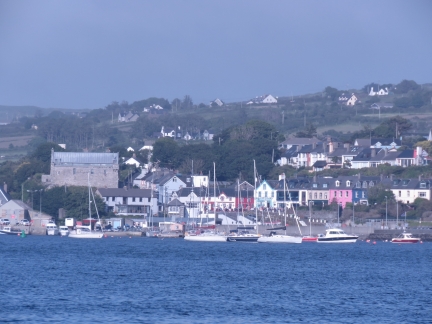 |
Baltimore
Position: -9 23.77, 51 28.83
The view to the town of Baltimore from our anchorage.
|
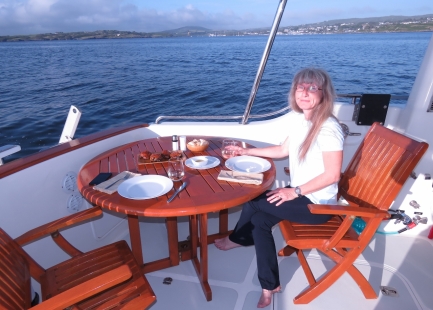 |
Dinner
Position: -9 23.77, 51 28.83
Grilled Peri-Peri chicken on the back deck. It’s wonderful to be out at anchor again. The last time our anchor was down was in early February in St. Augustine Florida, alhough that feels a lot longer than only four months ago.
|
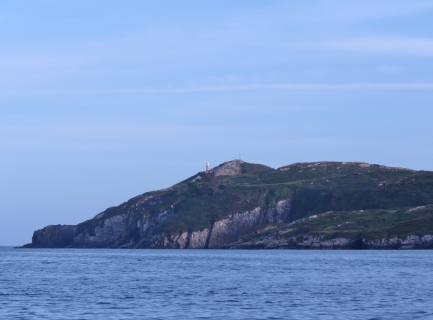 |
Lighthouse
Position: -9 23.77, 51 28.82
The lighthouse on Sherkin Island, on the south side of the entrance to Baltimore Harbour, viewed from our anchorage in the early evening. This sure is a beautiful anchorage.
|
 |
Dun na Long Castle
Position: -9 24.05, 51 28.71
Our first Irish castle. Dun na Long Castle on Sherkin Island, built sometime before the 1500s, overlooks the entrance to Baltimore Harbour. The castle, owned by the Irish O’ Driscoll clan, was badly damaged in a 1537 retaliatory attack on Sherkin Island by Anglo-Normans. It was restored in 1655 and now is part of the Islander’s Rest Bar and Restaurant property.
|
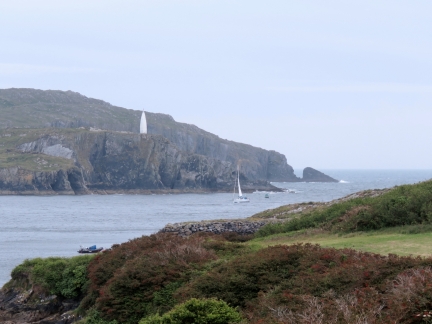 |
Beacon Point
Position: -9 24.10, 51 28.70
The view to Beacon Point from the road leaving the Islander’s Rest property.
|
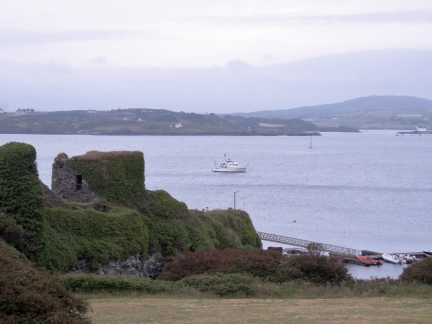 |
Dirona
Position: -9 24.12, 51 28.66
The first of what we expect will be many pictures of Dirona near an Irish castle. Our tender is just visible tied off third from the left on the Islander’s Rest pontoon.
|
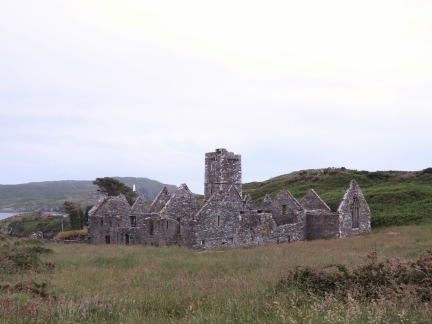 |
Friary
Position: -9 24.07, 51 28.59
A friary was established on Sherkin Island in 1460 by Fineen O’ Driscoll, chieftain of the area. The friary also was badly damaged in the 1537 attack on Sherkin Island.
|
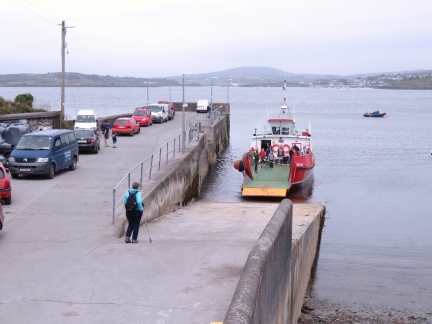 |
Ferry
Position: -9 23.98, 51 28.59
We’ve been seeing the ferry run regularly between Baltimore Harbour and Sherkin Island. Here the ferry is landing at Sherkin Island with a load to disembark and another load to embark.
|
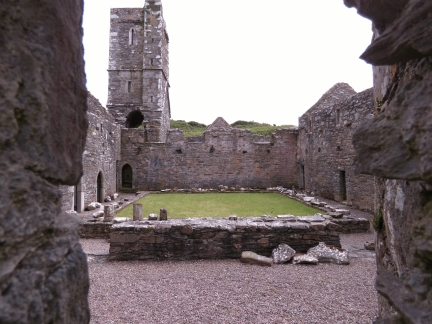 |
Friary Interior
Position: -9 24.01, 51 28.58
A view to the friary interior.
|
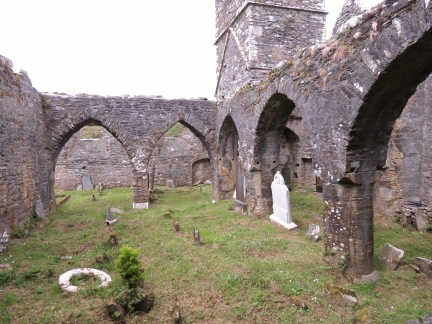 |
Graveyard
Position: -9 24.02, 51 28.56
A sign outside the graveyard warns that “Grave digging is a dangerous activity … and Authorities accept no liability for any injuries caused by grave digging, including those engaged in voluntary grave digging.” We were wondering how someone would find themselves grave digging involuntarily. Perhaps “the drink” would drive them to it. :)
|
 |
Window
Position: -9 24.02, 51 28.56
This window at the back of the friary likely contained a stained-glass windows.
|
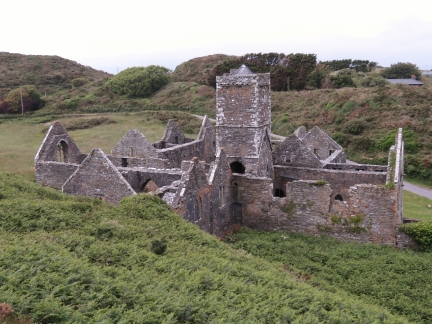 |
Abbey from Above
Position: -9 23.99, 51 28.54
We were trying to find a way to reach the lighthouse, so climbed above the friary looking for a route. It looked pretty challenging, so we bailed, but did get a nice view.
|
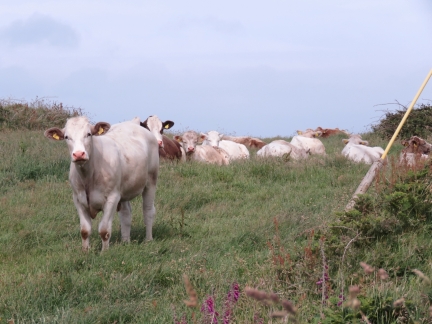 |
Bulls
Position: -9 23.76, 51 28.35
To reach the lighthouse, we eventually followed a path through what we thought was a cow field, but turned out to be a bull field. The animals are surprisingly nimble on the steep slopes—we saw hoof marks everywhere. The bulls were not at all frightened of us, and one even snorted and started walking toward us. A little more excitement than we bargained for.
|
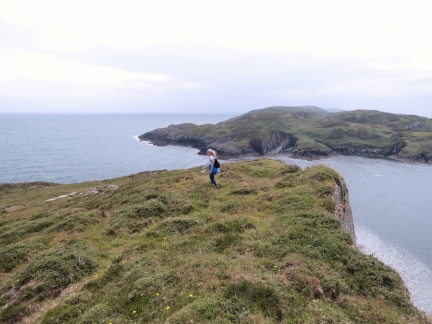 |
Barrack Point
Position: -9 23.77, 51 28.33
Jennifer taking in the view south to sea from Barrack Point.
|
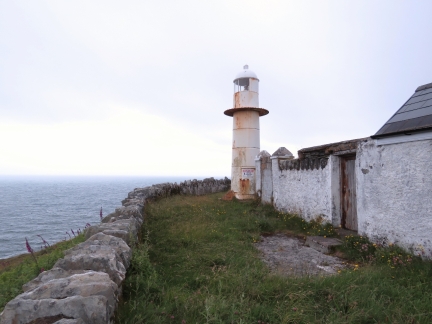 |
Lighthouse
Position: -9 23.68, 51 28.37
The light and house on Barrack Point. The light is automated and the house sealed up against trespassers.
|
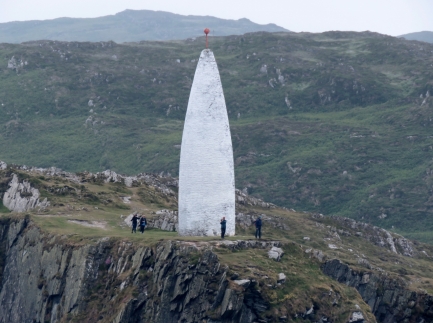 |
Beacon
Position: -9 23.68, 51 28.37
The Beacon across the entry channel is a popular destination. We always see people out there.
|
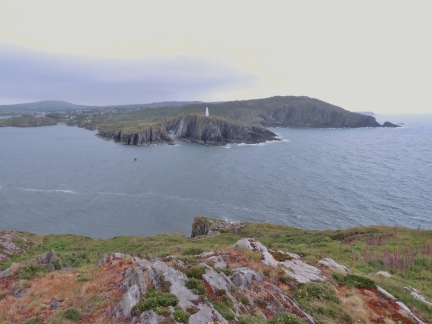 |
Entry Channel
Position: -9 23.69, 51 28.38
The view across the Baltimore Channel entry channel to the beacon on the other side as we depart Barrack Point.
|
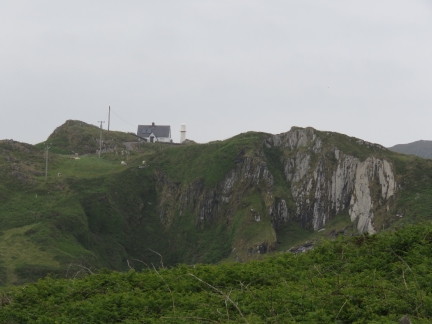 |
Horseshoe Loop
Position: -9 24.19, 51 28.27
Sherkin Island is several well-marked and nice trails. We picked up the shorter Horseshoe Loop on our return from Barrack Point. This is the view across Horseshoe Bay to the light and house on Barrack Point.
|
 |
Fuchsia
Position: -9 24.55, 51 28.24
Beautiful fuchsia grow wild throughout the Horseshoe Loop.
|
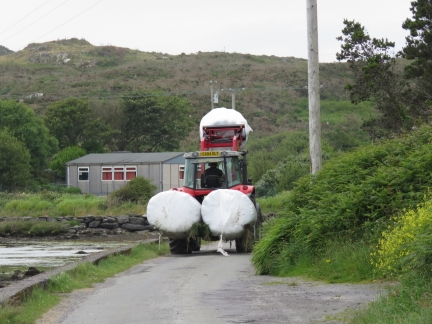 |
Tractor
Position: -9 24.55, 51 28.28
The Horseshoe Loop joins several other trails along a shore-side road. We followed a tractor that had to pull off to allow oncoming traffic.
|
 |
Rose
Position: -9 24.49, 51 28.32
Wild roses growing along the side of the road.
|
 |
Butterflies
Position: -9 24.42, 51 28.38
Outside the Sherkin Island National School are several posters with drawings the schoolchildren have made of the local wildlife.
|
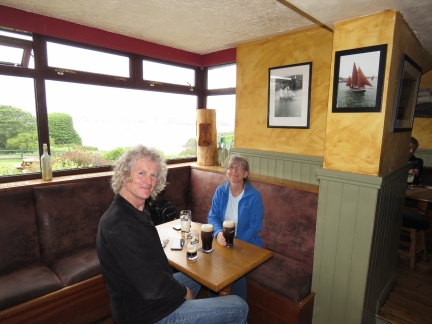 |
Islander’s Rest
Position: -9 24.12, 51 28.70
We finished the day with Murphy’s and dinner at the Islander’s Rest Pub with a great view over the harbour. Amazingly, the bar tender knows the owner of the Fastnet Pub that we frequented in Newport.
|
 |
Remote Maretron
Position: -9 24.10, 51 28.70
We’d been out for much longer than expected, which shows the importance of generator autostart to protect the batteries. So while we were having dinner we checked on the battery levels to make sure they were ok. It’s amazing to be able to see every data point on our comprehensive Maretron N2KView display no matter where we are.
|

|
Click the travel log icon on the left to see these locations on a map, with the complete log of our cruise.
On the map page, clicking on a camera or text icon will display a picture and/or log entry for that location, and clicking on the smaller icons along the route will display latitude, longitude and other navigation data for that location. And a live map of our current route and most recent log entries always is available at http://mvdirona.com/maps. |
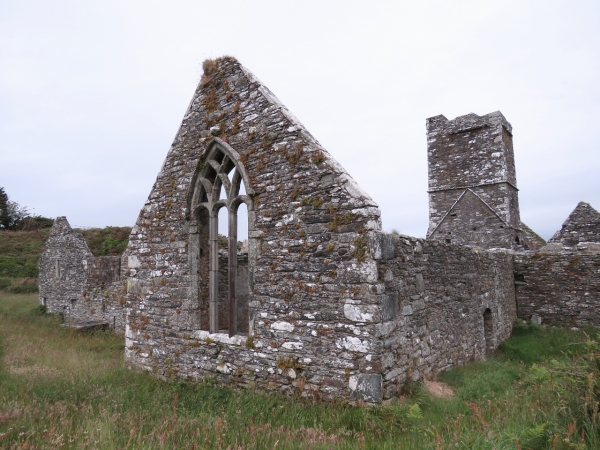
If your comment doesn't show up right away, send us email and we'll dredge it out of the spam filter.